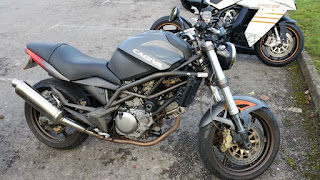Because Japanese motorcycles were so influential to motorcyclists who entered the sport in the 1960s and 1970s, the look of these bikes became imprinted in our psyches as the way a motorcycle should look.
These were pretty basic bikes : Back then, function dictated form. The gas tank sat above the engine to allow the gas to run down into the carburetors. The way the human body bends pretty much dictated the placement of the rest of the parts.
As motorcycles became more specialized in the 1980s, the look of motorcycles changed. Motorcyclists were so excited by new developments that we didn’t realize we were losing something in the process. Then one day in the late 1980s, we realized that the basic bike no longer existed. Motorcyclists began complaining about this situation, and soon the Japanese designed bikes that embodied the virtues of those older models.
Unfortunately, while the inclusion of the older styling features contributed to a retro look for these new machines, it also detracted from their overall versatility. Suzuki and Kawasaki were the first to come to the market with standard motorcycles. Kawasaki’s entrance into this new/old market segment was the Zephyr 550, a four-cylinder UJM-type bike introduced for the 1990 model year. The bike did not sell well in the United States. Very few of these machines found their way to the public highways, and they were soon dropped from Kawasaki’s lineup.
Suzuki’s entrant, the VX800 of the same year, did slightly better in the market. This was a full-sized, competent machine that fulfilled the promise of the versatile standard. In fact, it is a bike I highly recommend, whether to a beginner or a long-time motorcyclist. But it was never a sales dynamo and was imported to U.S. shores for only four years.
Neither Kawasaki nor Suzuki gave up on the concept of standard bikes after the lukewarm reception of their initial efforts. Kawasaki imported increasingly larger Zephyrs, but they came with increasingly larger price tags. None of the Zephyr series offered anything a rider couldn’t find in a used GPz 900 Ninja—and for a fraction of the Zephyr’s price.
Suzuki, in an attempt to recapture the sales success it had enjoyed with its big GS series of the 1970s and 1980s, brought out the GSX1100G, a big, 1980s-style standard with a modern, single-shock rear suspension. On paper, the Suzuki fulfilled every requirement those clamoring for standard bikes claimed to need from a bike.
But the GSX was even less successful than the VX. The reason probably involved the bike’s appearance. At the risk of offending loyal GSX riders, many people considered the bike to be goofy-looking. One magazine wag even suggested they take the coloring crayon away from the designer who conceived the machine. (For the record, I kind of like the bike’s look, if you get rid of the screwy high-rise handlebars and clean up the busy-looking front end.)
Honda was the first Japanese manufacturer to find relative success in the standard bike market, with its Nighthawk CB750. Here was a bike that offered the versatility UJMs were known for and looked good doing it. Perhaps the factor that contributed most to the bike’s success was its low price. In this case, you really did get your money’s worth. These were, and still are, great values for the money. My wife bought one of these bikes as her first full-sized motorcycle, and one of my greatest regrets is selling that bike.
While the Nighthawk was the first modern Japanese standard to hold its own in the marketplace, it never set any kind of sales records. It seemed the standard might once again disappear from the market, had a couple of manufacturers not rethought the concept.
First Yamaha introduced the Seca II 600. At first glance, this nimble, fun bike might not be considered a standard, since it included a small, framemounted fairing (a device that protects riders from the elements).
But riders didn’t care; the fairing just added to the bike’s practicality. It seemed that being naked (without fairing) was not a prerequisite for a standard. Suzuki also realized this and brought out its Bandit series. These bikes are comfortable motorcycles that incorporate the best technology available, a useful fairing, and a reasonable price.
The success of the Bandit spawned a resurgence in this type of motorcycle. Kawasaki was first to respond, introducing its ZRX1100, a bike that earned the nickname "Eddie Lawson Replica" because it used a paint scheme reminiscent of the bikes Eddie Lawson campaigned in AMA Superbike racing in the early 1980s. Suzuki fought back with a dramatically improved version of its Bandits, in both 600cc and 1200cc forms, and Yamaha entered the standard wars with its FZ1 (Fazer outside the United States). This bike uses the potent engine from Yamaha’s R1 open class sportbike, mounted in a steel frame with an upright riding position. Yamaha marketed this bike as "An R1 for the real world."
To drive home which bike Yamaha was targeting with the FZ1, it used Eddie Lawson himself in the television ads, because Lawson had achieved his greatest racing success at the international level aboard Yamaha motorcycles. Kawasaki didn’t take this lying down, and introduced a new bike for 2001, the ZRX1200, which was much better in every respect than the original ZRX1100. Finally Honda entered the market with a standard bike based on its CBR900RR (Fireblade outside the United States).
The fierce competition in this category indicates that there is a strong market for standard-style streetbikes. If you’re a fan of these types of bikes (which I am), this is a great time to be a motorcyclist.

